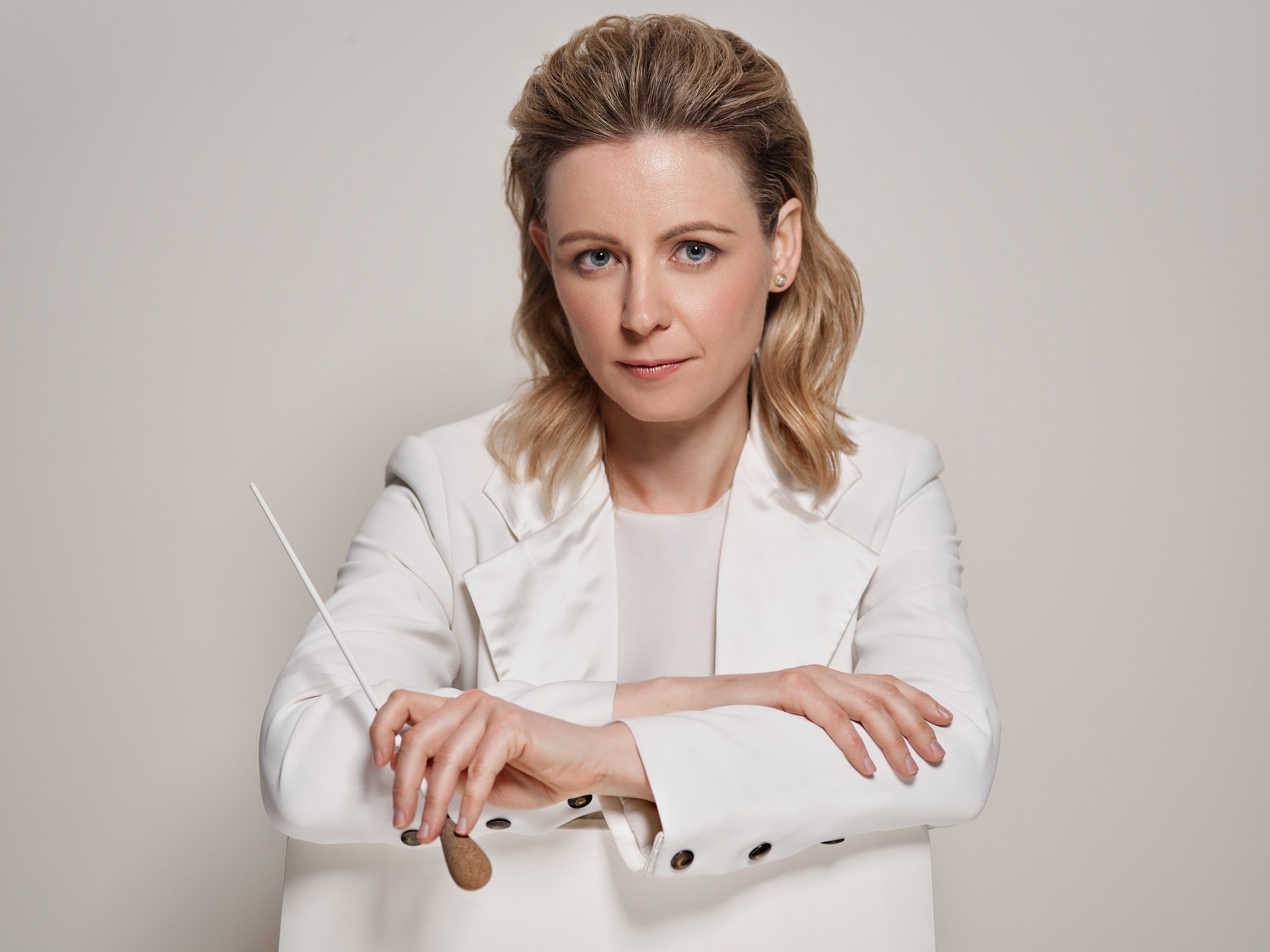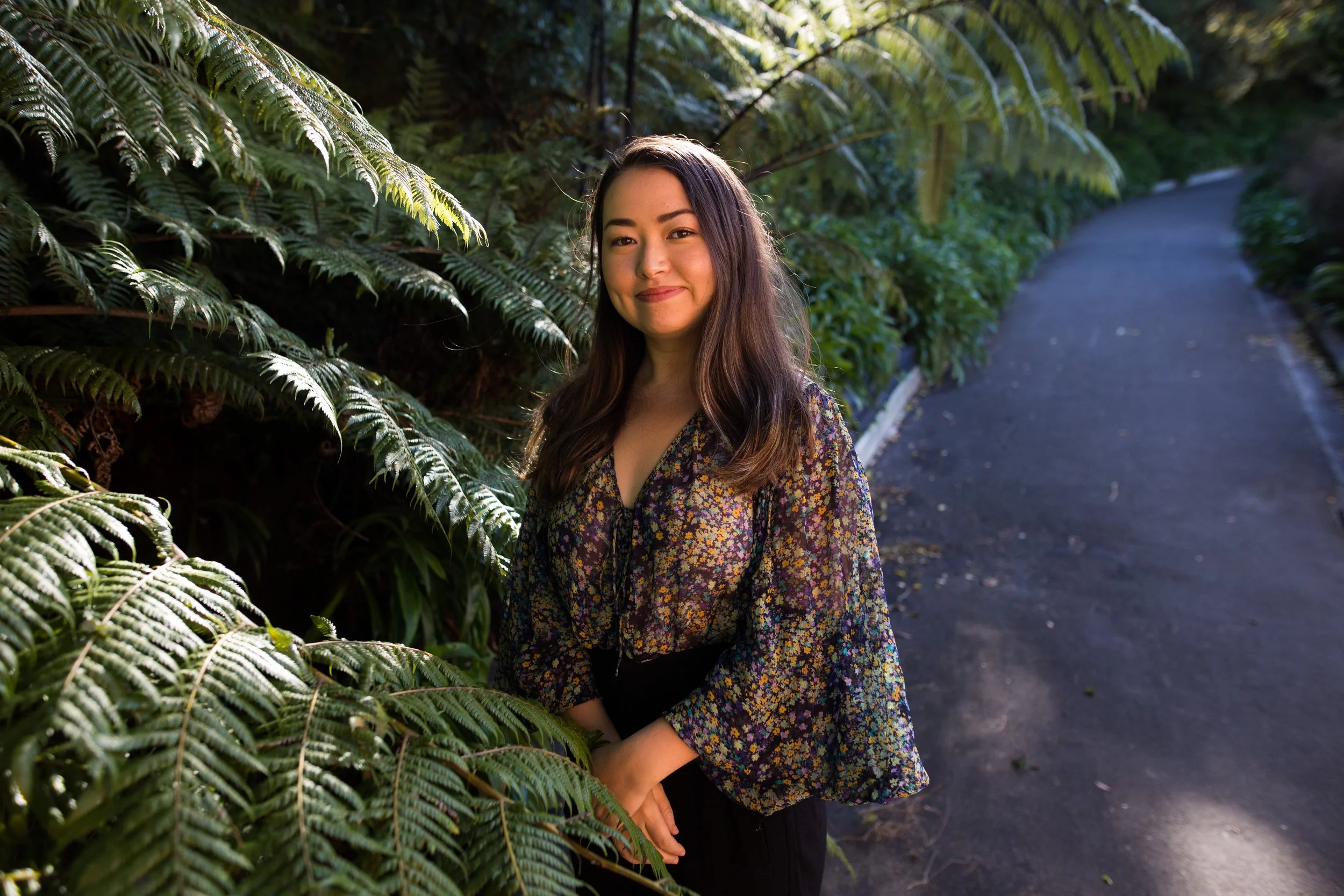NZSO’s Mahler 5: brilliance and insight
Conductor Gemma New with the NZSO and percussion soloist Jacob Nissly
“…in empathetic command of the orchestra.”
Image credit: NZSO/Jono Tucker
I almost called this review “in praise of Gemma New”. Of course, the concert NZSO presented as “Mahler 5” was as much about the compositions as the performances, but New’s brilliant, intelligent and nuanced conducting added a huge amount to everyone’s enjoyment. Dynamic on the podium, sometimes dancing with the music, she seemed utterly in tune with all three compositions and in empathetic command of the orchestra.
Mahler’s 70-minute Fifth Symphony was the major work of the programme and showed off the strengths of the NZSO. If there’s anyone left in the classical musical audience who isn’t sure they like Mahler’s music, this performance of the marvellous work would surely have won them over.
The first of five movements is a funeral march, opening with a solo trumpet call. The distinctive fanfare, knowingly reminiscent of the opening of Beethoven’s 5th, was played by Principal Trumpet Michael Kirgan with understated and musicianly beauty. His solo work throughout the symphony was outstanding, amply acknowledged in the final ovations. This movement is darkly romantic, mostly in a minor key and full of stirring drama and sly hints of Weimar cabaret. The Mahlerian harmonies are gorgeous, and we’re reminded that Mahler is essentially Viennese, his melodies singing forth, beautifully and flexibly shaped by New.
Michael Kirgan, the NZSO’s principal trumpet
“…playing of understated and musicianly beauty.”
The trumpet fanfare returns at the end of the movement, which is punctuated by a final pizzicato string chord, placed with exquisite precision by New. Her management of detail combined with a sense of the symphonic big picture was evident throughout.
In the 2nd stormy movement, a dramatic, energetic theme alternates with a gentler one of Viennese grace. The pace and shape of a tragic unison cello melody was beautifully judged and the orchestral ensemble balance impeccable throughout in Mahler’s signature harmonically infused counterpoint, the composer painting his lines with colours. This Symphony is a great vehicle for the NZSO, showing off the solo brilliance of several section principals and its fine brass and woodwind choirs, warm, expressive string sound and highly professional and versatile percussion section.
Mahler’s delicious eccentricity is fully evident in the third movement, a scherzo in triple time, waltzing through the orchestral colours. New’s interpretation showed a deep understanding of Mahler; her charmingly quirky attention to detail worked perfectly, almost sending the music up. A lovely solo by Principal Horn Sam Jacobs was a highlight, followed by his great leadership of the brilliant horn section in a dramatic moment later in the movement.
Conductor Gemma New
“…a deep understanding of Mahler
Photo credit: Roy Cox
The Symphony’s 4th movement Adagietto is perhaps one of Mahler’s most famous works, mainly because of its use in Visconti’s film Death in Venice. After the major work-out for winds and brass in the preceding movements, Mahler the orchestral pragmatist gave them a break by scoring the Adagietto for strings and harp alone. There’s nothing else pragmatic about this romantic love song to his wife Alma, however, and the NZSO strings and Principal Harp Carolyn Mills touched our hearts with a beautiful performance under New’s sensitive baton.
By now the mood of the 5th Symphony has shifted from dark to joyous and the final movement, again featuring brass and winds, rushes onward towards a triumphant conclusion. New is absolutely in charge of Mahler’s clarity of construction; even at pace, the music dances, strings ever tuneful, with interruptions from droll little episodes adding to the good humour. The big build up to the climactic ending was deeply satisfying.
The concert began with an orchestrated version of work I’ve got to know through more than one performance by the NZ Trio, who commissioned it. Kintsugi, by New Zealand composer Salina Fisher, is named after the ancient Japanese art of repairing broken pottery with gold. Fisher sees kintsugi as “a metaphor for embracing 'brokenness' and imperfection as a source of strength.” Fisher acknowledges her Japanese heritage with the lovely work, which involves, she says, “musical fragmentation, fragility, mending, and finding beauty in the cracks”.
Composer Salina Fisher
The title of her lovely work Kintsugi is “a metaphor for brokenness as a source of strength”.
Image supplied
The gentle beauty of the chamber version is retained in the orchestral Kintsugi, with Fisher’s explorations with timbre now drawing from a wider palette. It begins with birdsong-like flute, strings and harp, then oboe, the effect perhaps more directly illustrative than the trio version. The bassoon plays the part originally written for cello, brassy colours make an appearance and the wide-spaced chords of the original trio are gorgeous with full strings including basses. New held the final silence for several seconds, maintaining the works almost reverent atmosphere. I hope New will take Kintsugi to other orchestras around the world, as she has done successfully with Fisher’s earlier orchestral work Rainphase.
The third, centrally-placed work in the fairly long programme was Losing Earth by American composer Adam Schoenberg. The composer, a father of young children, is bringing a message about the climate crisis to a percussion concerto written specifically for the soloist, American Jacob Nissly, Principal Percussionist of the San Francisco Symphony. It’s a single movement work with three clearly defined sections, called Dark, Fiercely Strong and Relentless, Delicate and Airy, and Beast Mode. It’s also, the composer told us, something of a history of percussion music.
Earplugs were offered in advance and when the work began, six bass drums placed around the auditorium (including one less than 2 metres behind me) sounded like gun shots. These dramatic and startling effects were framed by silence. The simple brass choir had jazz underpinnings and a toe-tapping repetitive syncopated rhythm section accompanied Nissly (whose background is in marching bands) as he proceeded through the audience to the stage with his drum. The first section ended as he put it aside and sat on a wooden box, an instrument known as a cajón, playing it with his hands.
Composer Adam Schoenberg
“…an enthusiastic audience response to his work Losing Earth and its climate-related theme”.
Photo supplied
The Delicate and Airy section is in stark contrast, gentler metallic percussion including gamelan gongs, lovely watery effects, a horn call and wind melodies with sustained strings in accompaniment. The composer suggests the sounds might evoke a world “where Mother Nature reclaimed our beaches and we all simply faded into the ocean.” Orchestral chords and strings soaring upwards bring a hint of Hollywood from this Los Angeles-based composer.
Accompanied by foreboding bass drum, the soloist moved to the third percussion station of bright, wooden instruments, the darkness reinforced by contrabassoon. Beast Mode took off, fast and virtuosic, sprays of snare drumming, bass drums around the hall back in action as the work races to its atmospheric conclusion, seven small roto-sound cymbals played by the soloist, in the orchestra and around the hall.
Ultimately, the piece felt a little naïve, not fully avoiding movie music cliché, and using the percussion to make its points with little subtlety. But many in the audience loved it, standing to shout their approval. Nissly is undoubtedly a virtuoso and performed with flair and skill, and the audience responded to Schoenberg’s climate-related theme.
Schoenberg wrote his Losing Earth (2018) in his late thirties, for Nissly who is a similar age. Fisher has already had extensive international success and it’s sometimes hard to believe this talented composer only recently turned 30. With the NZSO baton in the hands of 37-year-old New, it was a concert celebrating the brilliance of an exciting younger generation of musicians.
Jacob Nissly, percussion soloist, in Beast Mode, the final movement of Schoenberg’s percussion concerto, Losing Earth.
“…a celebration of an exciting younger generation of musicians.”
Photo credit: NZSO/Jono Tucker
The full house included a contingent of younger concert-goers, too, many vociferous in their enthusiasm for the performances. In a recent article in the UK’s BachTrack, a research report called Tomorrow’s Audience about post-pandemic audiences pointed out that “not only are audiences for performing arts returning, but they are doing so in greater numbers. A significant percentage are new visitors, new to the performing arts altogether, younger and more diverse than ever before.”
Maintaining existing loyal audiences and welcoming new ones simultaneously has always been a challenge for the performing arts. With “Mahler 5”, the NZSO undoubtedly pulled it off. The concert affirmed my belief that high-quality, compelling performances of interesting classical repertoire are more likely to be successful in attracting new audiences than the pop-based non-classical strategies some organisations are pursuing with dubious box office results. There’s so much wonderful classical repertoire available – let’s hear it!
NZSO Mahler 5: Music by Salina Fisher, Adam Schoenberg and Gustav Mahler with Gemma New (conductor) Jacob Nissly (percussion) Wellington 5 April 2024






